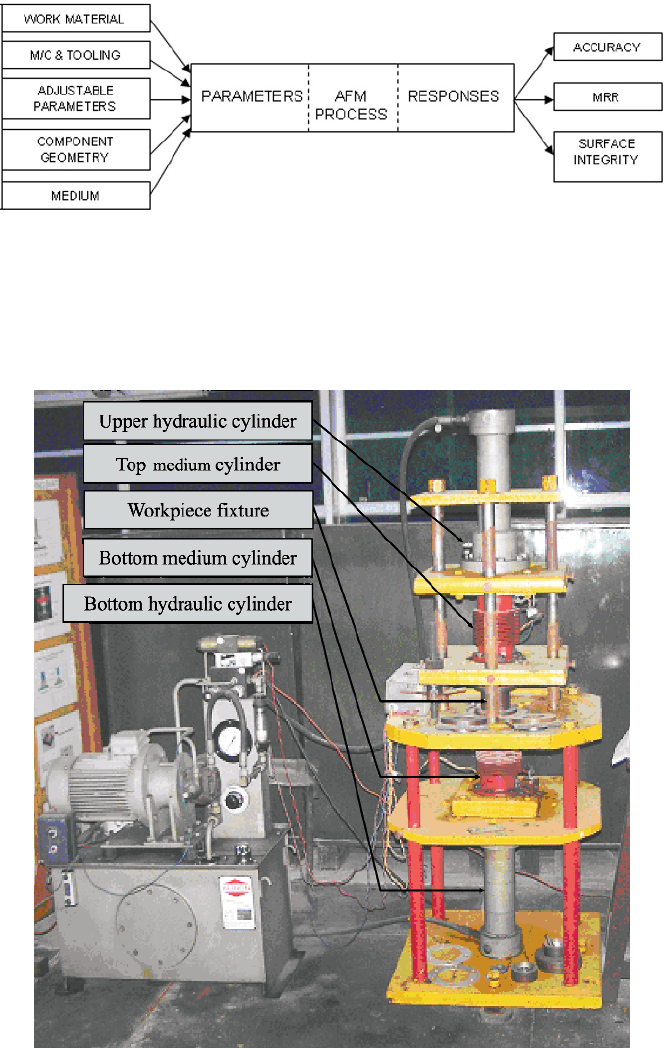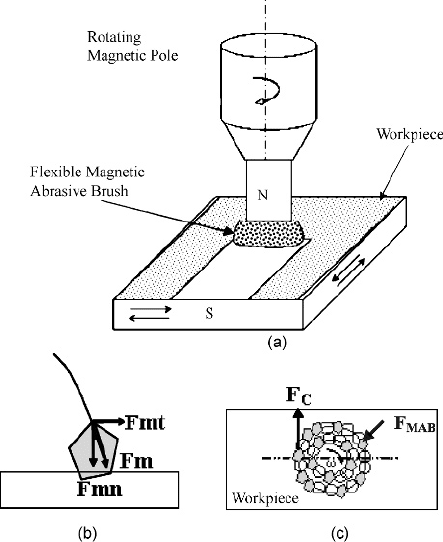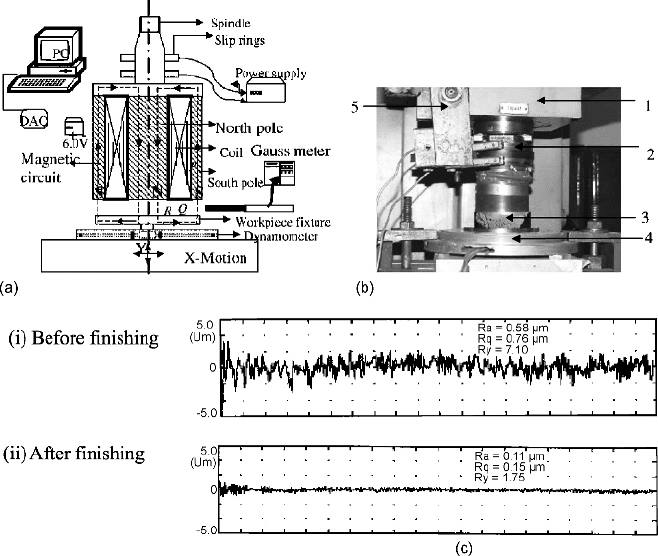Davim J. Paulo (editor). Machining. Fundamentals and Recent Advances
Подождите немного. Документ загружается.

Advanced (Non-traditional) Machining Processes 313
welding, laser chemical vapour deposition (LCVD) and surface hardening. These
applications require uninterrupted supply of energy for melting and phase trans-
formation. Controlled pulse energy is desirable for processes such as cutting, drill-
ing, marking etc., so that the heat-affected zone (HAZ) is minimal.
LBM is capable of machining refectory, brittle, hard, metallic and non-metallic
materials. As long as the laser beam path is not obstructed, it can be used to ma-
chine in otherwise inaccessible areas. LBM is suitable for drilling very small-
diameter holes with a reasonable large aspect ratio. LBM is used for drilling, tre-
panning, trimming, marking, welding and similar other operations. It is used for
both micromachining as well as macromachining. LBM has also been used for 3D
machining, namely, threading, turning, grooving etc. [13].
11.4 Electrochemical Advanced Machining Processes
11.4.1 Electrochemical Machining (ECM)
ECM works on the principle of Faraday’s laws of electrolysis. The noteworthy
feature of electrolysis is that electrical energy is used to produce a chemical reac-
tion, therefore the machining process based on this principle is known as electro-
chemical machining (ECM). In ECM, a small DC potential (5–30 V) is applied
across two electrodes (the workpiece being the anode and the tool the cathode).
Electrolyte flows in the gap between these two electrodes (Figure 11.13). Transfer
of electrons between ions and electrodes completes the electrical circuit. During
the flow of current in the circuit, metal is detached atom by atom from the anode
surface and appears in the electrolyte as ions (Fe
2+
). These ions form the precipi-
tate of metal hydroxides (Fe(OH)
2
) (Figure 11.13). During the electrolysis of wa-
ter, its molecules gain electrons from the cathode so that they separate into free
hydrogen gas and hydroxyl ion as
2
22
−−
+→↑+
2
H
Oe H OH.
As the anode dissolves, positively charged metal ions appear in the electrolyte,
which combine with negatively charged hydroxyl ions to form metal hydroxides
as
2
2
−+
−→
F
ee Fe
2
2
2
+−
+→
F
eOHFe(OH).
These hydroxides are insoluble in water hence they appear as a precipitate and
do not affect the chemical reaction. Ferrous hydroxides may further react with
water and oxygen to form ferric hydroxides.
22 3
24++→
2
F
e(OH) H O O Fe(OH) .

314 V.K. Jain
Tool (cathode)
feed
Workpiece
(metal)
H2
Electrolyte
( 20 - 30 m / s )
2 - 35 kg / cm
Metal
dissolution
from workpiece
++
M
++
M
Hydroxyl ion
2
OH
OH
H
2
+
Metal
hydroxides
Hydrogen
generation
at cathode
Flow of
electrons
( 5 - 20 V )
-
y
Figure 11.13. Schematic diagram of electrochemical machining
During ECM, metal from the anode is removed atom by atom by removing
negative electrical charge that binds the surface atoms to their neighbours. The
ionized atoms (say, Fe
2+
) are attracted away from the workpiece by an electric
field. The rate of removal of Fe
2+
from the anode is governed by Faraday’s laws of
electrolysis. The amount of chemical change m (the substance deposited or dis-
solved) is proportional to the amount of charge passed through the electrolyte. The
amount of change produced (substances deposited or dissolved) by the same quan-
tity of charge is proportional to the chemical equivalent weights of the material.
These laws can be expressed as follows:
m
∝
I t
and m
∝
E
Therefore,
F
Z
AIt
F
ItE
m
.
==
(11.1)
where I is the current (A), t is the time (s), E is the gram-equivalent weight of
material (or A/Z, where A is gram atomic weight and Z is the valency of dissolu-
tion), F is Faraday’s constant (96500 As), and m is mass of the metal dis-
solved/deposited (g). Dividing both sides of the above equation by time t will give
MRR
g
(the material removal rate in units of g/s) as
•
===
g
mIE
M
RR m .
tF
(11.2)
To obtain the volumetric material removal rate MRR
v
, divide both sides of
Equation (11.2) by the density of the metal (or alloy) as
ρρ
==
g
v
aa
MRR
I
E
MRR
F
(11.3)

Advanced (Non-traditional) Machining Processes 315
This equation can be used to calculate the linear material removal rate MRR
l
by
dividing it by cross sectional area (A
r
) of the tool (or smaller electrode):
ρ
=
l
ar
I
E
MRR
A
F
(11.4)
The accurate evaluation of m from Equation (1) is difficult when the anode is
an alloy because the value of E for the alloy is not known. It can be evaluated
either by the percent-by-weight method or the superposition-of-charge method.
Furthermore, many elements have more than one valency of dissolution. The exact
valency of dissolution under the given machining conditions should be known
because E
=
A/Z. The current I is the function of applied voltage (V), interelectrode
gap (IEG) and electrolyte conductivity (k). The gap between the bottom surface of
the tool and the top dissolving surface of the workpiece is known as the inter-
electrode gap (IEG), abbreviated as y. The smaller the IEG, the greater the current
flow (or current density) will be. Furthermore, MRR
g
depends on the current effi-
ciency (
η
), which usually varies between 75% and 100%. Theoretically, the MRR
depends upon the current passing through the workpiece and its chemical compo-
sition. To maintain a constant gap (or equilibrium gap), the tool should be fed
towards the workpiece at the rate (f) at which the workpiece surface is recessing
downwards (MRR
l
). Hence,
f
=
MRR
l
(11.5)
11.4.2 ECM Machine
An ECM machine tool consists of four main subsystems: the power source, the
electrolyte cleaning and supply system, the tool and tool feed system and the work
and work holding system. The power source supplies a low-voltage (5–30 V)
high-current (as high as 40 kA) rectified DC power supply. Figure 11.14 shows a
photograph of a simple low-capacity ECM machine.
The electrolyte supply and cleaning system consists of a pump, filters, piping,
control valves, heating/cooling coils, pressure gauge and a tank/reservoir. These
elements should be made of anti-corrosive materials because the electrolyte used
is corrosive in nature. Tools are also required to operate in a corrosive environ-
ment for a long period of time. Hence, they should also be made of anti-corrosive
material having high thermal and electrical conductivity, and easy-to-machine
characteristics (high machinability). Copper, brass and stainless steel are com-
monly used materials for making ECM tools. It is important to know that only
electrically conductive materials can be machined by this process. However, work
holding devices are made of electrically non-conducting materials having good
thermal stability, corrosive resistance and low moisture absorption. Glass-fibre-
reinforced plastics (GFRP), Perspex and plastics are some such materials that can
be used to fabricate work holding devices.
To exploit the full potential of the process, many allied processes/operations
have been developed using the principle of anodic dissolution described above.

316 V.K. Jain
Some of the allied ECM operations are electro-chemical boring, electro-
chemical broaching, electro-chemical ballizing, electro-chemical drilling, elec-
tro-chemical deburring, electro-chemical die sinking, electro-chemical milling,
electro-chemical sawing, electro-chemical micromachining, electro-chemical
turning, electro-chemical trepanning, electro-chemical wire cutting, electro-
stream drilling and shaped tube electromachining (STEM) [1]. Shaped tube
electro-chemical drilling (STED) has been successfully used to drill small-
diameter high-aspect-ratio holes in difficult to machine materials such as ni-
monic alloys (Figure 11.15) [14].
To enhance the capabilities of the base process (here ECM), two or more
processes are combined together to make it a hybrid process. Some of these hybrid
processes are electro-chemical grinding (ECG) [15], electro-chemical honing
(ECH) [16], and electro-chemical spark machining [17–22]. Such hybrid pro-
cesses give better performance than the constituent processes (ECM
+
grinding,
or ECM
+
honing or ECM
+
EDM).
Figure 11.15. Photograph of a nimonic super alloy part in which a 100-mm-deep hole has
been drilled using the STED process [14]
Figure 11.14. ECM machine (Courtesy: Metatech Industries, Pune, India)
Flow Meter
Machine Chamber
Control Panel with DC Power
Electrolyte
Recirculation
System

Advanced (Non-traditional) Machining Processes 317
11.5 Fine Finishing Processes
11.5.1 Abrasive Flow Machining (AFM)
With today’s focus on total automation in the flexible manufacturing systems,
the abrasive flow machining (AFM) process offers both automation and flexibil-
ity. This process was developed basically to deburr, polish and radius difficult-
to- reach surfaces and edges by flowing abrasive laden polymer, to and fro in two
vertically opposed cylinders (Figure 11.16(a)) [23,
24]. The medium (a mixture of
(a)
(b)
Figure 11.16. (a) Schematic diagram of abrasive flow machining setup: 1 – hydraulic oil in-
let/outlet port, 2 – hydraulic cylinder, 3 - medium cylinder, 4 – smooth entry profile, 5 – Top
cover plate, 6 – dynamometer for force measurement, 7 – central hub, 8 – split cylindrical
fixture with workpiece, 9 – botSstom cover plate, 10 – support frame, 11 – hydraulic oil
outlet/inlet port, 12 – medium with abrasive particles. (b) Types of forces acting on a grain [23]

318 V.K. Jain
Figure 11.17. Variables and responses of AFM process
visco-elastic material, say, polyborosiloxane, additives and abrasive particles) enters
the workpiece through the tooling. The abrasive particles (SiC, Al
2
O
3
, CBN, dia-
mond) penetrate the workpiece surface depending upon the extent of the radial force
Figure 11.18. Experimental AFM setup [I.I.T. Kanpur]

Advanced (Non-traditional) Machining Processes 319
acting on them. Due to the tangential/axial force, the material is removed in the form
of microchips as shown in Figure 11.16(b). The medium is recirculated until the
concentration of foreign particles increases to a level such that its finishing rate de-
creases substantially. At this time part of the used medium (say, 20%) is replaced by
fresh medium. Figure 11.17 shows the variables and responses of the AFM process.
There are three major elements of the AFM system: the tooling, the machine, and
the medium. Figure 11.18 shows a photograph of an AFM machine developed at IIT
Kanpur for research and development activity. The tooling confines and directs the
medium flow to the areas where abrasion is desired. The machine controls the extru-
sion pressure, which controls the medium flow rate. The abrasive-laden polymer is
the medium, whose rheological properties determine the pattern and aggressiveness
of the abrasive action. The rheological properties of the medium change during the
AFM process and they substantially influence the process performance [25]. This
process can be applied for finishing multiple pieces of the same shape and size (Fig-
Figure 11.19. (a) Finishing of multiple parts having the same configuration. (b) Finishing of
two parts but with different configurations. (c) Finishing and radiusing of an internal hole.
(d) Tool for deburring and finishing of a gear using the AFM process. (e) medium acting as
a self-deformable stone in the case of a complex, convex and concave component [1]

320 V.K. Jain
ure 11.19(a)), and also of different size (Figure 11.19(b)). It can radius the edges of
a part (Figure 11.19(c)) and can finish a complete gear in one go (Figure 11.19(d)).
The medium acts as a self-deformable stone and can finish concave, convex as well as
complex-shaped components (Figure 11.19(e)). It also has some peculiar applica-
tions as well where no other traditional and advanced finishing processes can work.
For example, a large number of small-diameter holes (say, diameter 3 mm and depth
30 mm) can be easily and simultaneously finished by this process, which is otherwise
very difficult. This process can be used to control the surface finish of the cooling
holes in a turbine blade, or the surface finish of stator and rotor blades of a turbine.
The best surface finish achieved by this process is 50 nm.
11.5.2 Magnetic Abrasive Finishing (MAF)
In the magnetic abrasive finishing (MAF) process, granular magnetic abrasive
particles (MAPs) [sintered ferromagnetic (iron) particles and abrasive grains (say,
Al
2
O
3
, SiC, or diamond)] are used as cutting tools and the necessary finishing
pressure is applied by an electromagnet-generated magnetic field. Figure 11.20(a)
shows the working principle of the MAF process through a schematic diagram.
Figure 11.20. (a) Plane magnetic abrasive finishing of magnetic work material. (b) Schematic
diagram showing the normal (F
mn
) and tangential components (F
mt
) of the magnetic force (F
m
)
acting on a magnetic abrasive particle. (c) FMAB and the cutting force (F
c
) acting on an
abrasive particle

Advanced (Non-traditional) Machining Processes 321
The magnetic abrasive particles join each other magnetically between two mag-
netic poles (S and N) along the magnetic lines of force, forming a flexible mag-
netic abrasive brush (FMAB). When there is relative motion between the FMAB
and the workpiece, abrasion takes place to give a polished finish. This finish can
be as good as approaching to 50 nm, depending upon the machining conditions
and workpiece material. The performance of the process depends on the parame-
ters such as the MAP (type, size and mixing ratio), the working clearance (the gap
between the workpiece surface being finished and the bottom face of magnetic
pole), the rotational speed of the poles, the feed motion (x and y motion) of the
workpiece, vibration (frequency and amplitude), the properties of the work mate-
rial and the magnetic flux density [26–31].
Figure 11.20(b) shows the magnetic force (F
m
) and its components: the magnetic
normal force (F
mn
) acting on a MAP due to the magnetic field, and the tangential force
(F
c
) acting mainly due to the rotation of the magnet (Figure 11.20(c)). There is a small
contribution F
mt
to this force F
c
as a component of F
m
(the magnetic force).
Figure 11.21(a) shows a schematic diagram of a magnetic abrasive finishing
setup for plane surfaces. It shows the major elements of the setup, while Fig-
Figure 11.21. (a) Schematic diagram of plane magnetic abrasive finishing process setup.
(b) Photograph of the plane MAF setup: 1 – column of a milling machine, 2 – slip ring, 3 –
FMAB, 4 – ring dynamometer, 5 – slip ring attachment [28]. (c) Surface roughness plots (i)
before, and (ii) after magnetic abrasive finishing of a stainless-steel workpiece

322 V.K. Jain
ure 11.21(b) shows a photograph of a part of a setup. Figure 11.21(c) shows the
surface finish before (0.58 μm) and after (0.11 μm) MAF on a stainless-steel
workpiece. This process can also be used to improve the surface properties by the
process of diffusion of traces of MAP into the workpiece surface. Proper tooling
can be developed to finish 3D intricate shapes because FMAB adapts to the shape
of the workpiece, however it is not as flexible as the AFM medium.
Achieving uniform surface finish near the discontinuities or edges in the mag-
netic poles is difficult. At irregularities, the magnetic flux density is greater, hence
the rate of change in surface roughness is also higher compared to other areas.
There are various other areas in which research needs to be done, such as work-
piece surface temperature and the forces acting on the workpiece during MAF
processing. The effect of various parameters on responses such as MRR, surface
roughness and out-of-roundness (in the case of cylindrical workpieces) have been
reported [28,
29].
11.5.2.1 Internal Magnetic Abrasive Finishing
MAF can also be used for finishing internal surfaces. MAPs are blown with high
pressure air jet. When the MAP jet comes into the domain of magnetic field, the parti-
cles slightly divert towards the source or pole of the magnetic field (the internal
surface of the workpiece) and move forward due to an axial force (F
c
), shearing
the peaks off the internal surface. The path of the jet of the magnetic abrasive
particles is slightly deviated due to the magnetic field force (F
m
) (Figure 11.22)
[32] so that the MAP flow abrades the internal surface of the tube. The velocity of
Figure 11.22. Magnetic abrasive jet finishing
Nozzle
Pressure
Gauge
Abrasive Tank
N
S
+
_
Compressed Air
Magnetic Pole
Work
Piece
Stabilized DC Power
Magnetic Abrasive
Particles
MAP
Work
F
mn
Shaft
F
c
